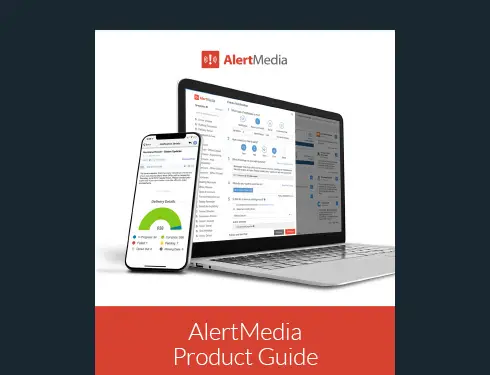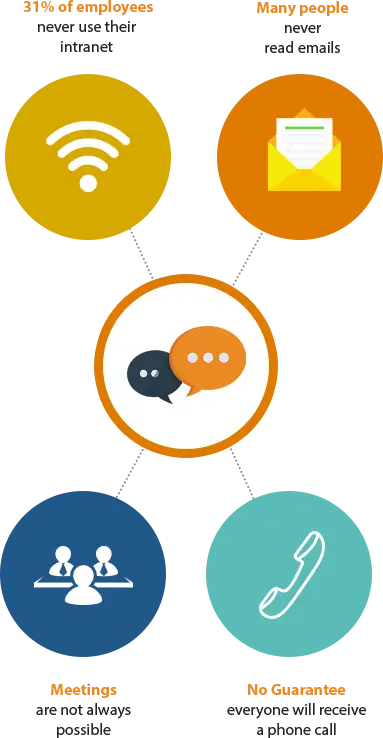
Is Employee Communications Software Really Necessary?
If it doesn’t utilize modern employee communications software, your company and employees could be at risk.

How Do We Communicate?
Ask any organization how it communicates and it will likely tell you “through email and lots of meetings.” Most companies live and breathe by email and probably would admit they spend far too much time in conference rooms. They’ll probably also tell you their system works just fine and there is no reason to add complicated employee communications software to the mix.
Before jumping to conclusions or making any assumptions, let’s dig into what employee communications are and why it is so important. One definition of employee communications is “communications and interactions among employees or members of an organization.” Sounds simple enough, but the larger the organization becomes, the more challenging these “interactions” can become. Growing companies often struggle to find the right communication solution to fit their organization and scale as their needs change.
Employees expect some level of communication from their employers, and they are much more likely to succeed when they have proper channels to communicate with each other. They can be more productive, feel more connected, and stay motivated when they know what is expected of them.
Effective employee communication can also bridge departmental silos and better control the messaging employees receive, taking a proactive approach with transparent messaging when external sources attempt to drive the dialogue. In essence, good corporate communications help build a strong workforce community.
In the past, companies would hold a town hall or “all hands on deck” meetings with employees. Meetings were held by team, department, or company-wide. These meetings provided the ideal platform for executives and business leaders to present the “state of the company” addresses, introduce new products (think Steve Jobs) or services, rally the troops, launch a campaign, or simply boost morale. Oftentimes, the meetings came with great fanfare and much thought was put into the messaging, presentation, and delivery.
That was then. Today’s companies are often too geographically dispersed and/or too large to expect every employee to attend, much less afford to have them attend. Even finding the space to hold the meetings presents its own challenges. Companies today also frequently have a large number of traveling employees, employees who work in shifts, and employees who work remotely. It is not feasible for most companies to hold these types of meetings and ensure every employee gets the messaging they need. Even if they do manage to organize such an event, it is likely to happen once a year.
Today, however, companies have more options. Mobile phones and devices, email, internal chat tools, and intranet sites are the most common communication channels, but they also are only as beneficial as how they are being used. Mass communications software holds the answers.
What’s So Wrong About Our Employee Communications?
Email is likely the channel most organizations depend on to send employee communications. These can come in the form of company, departmental, or team newsletters and announcements, emergency notification, and operational instructions. Email allows for the creation of recipient distribution lists so employees can be segmented and it typically enables employees to respond.
The problem with depending on email alone is that most people are overloaded with emails and few stand out. Emails never stop coming from coworkers, customers, suppliers, partners, schools, family and friends, and everyone in between. We get inundated with advertisements and offers, promotions, and marketing dumps. The average person receives up to 121 emails per day, leading many of us to delete or disregard a large portion of them. Organizations cannot depend on email as their sole source of communication.
The Intranet poses other problems. Intranets are a fantastic source for employees to find information and complete certain tasks, for example, updating their benefits or profile information. Most employees, however, do not take the time to check intranet sites regularly for anything else. One report found 31% of employees never use their intranet. Perhaps it is because the intranet has too much information. It can be overwhelming to see a web page covered in text, jargon, calendars, tips, instructions, and reminders. It’s easier for some to just ignore it and assume the important stuff will get to them somehow.
In an emergency situation, phone calls are often made to alert those employees in harm’s way of impending danger and offer instructions on their next course of action. You can probably guess the problem with this communication method. People simply do not check voicemail as often as they used to and if they do not recognize the phone number on their caller ID, they may never pick up. An organization may reach some of its employees via phone calls, but there’s no guarantee everyone will receive the message.
If meetings are not always feasible; emails are iffy; intranet sites are out of sight, out of mind; and phone calls are unreliable; what are companies supposed to do if they want to effectively communicate with their employees across the organization?

How Can We Improve Employee Communications?
Good communication is paramount for any business to succeed. Whether it’s to communicate good news or bad, employees need to know what’s going on as quickly as possible. Employees who feel their companies are being honest with them, care about them, provide resources for them, and want to listen to them are going to be more engaged, motivated, and loyal. It’s to the organization’s benefit to have an effective employee communication strategy in place that really connects its workers to each other and to the corporation as a whole.
The first step in improving employee communications is to use communication channels that actually reach employees, wherever they are. Meetings, email, intranets, and phone calls may reach some, but as we all know, there are many more communication channels we now use. Including texts, app push notifications, messaging platforms like Slack, and event pages into a communications strategy are some of the best ways you can connect with all of your employees.
Mass communication software will enable you to send messages across all of these channels, even custom channels, simultaneously so you know your message is being received loud and clear. While not every message warrants an all-channel blast, some situations do, either to specific departments and teams or company-wide:
- Manufacturing disruptions
- Supply delays
- Shift needs
- Power outages
- IT outages or scheduled maintenance
- Weather-related incidents
- Natural disasters
- Fires
- Workplace violence
- Threats of violence
- Hazardous materials spills
Tailoring the messaging to fit the channel is important. Texts and push notifications are preferred to be brief but can provide links to the company intranet site, social media page, or external sources for additional information. Emails can give as much detail as necessary and provide links as well. Voice calls can offer plenty of instruction and information while also providing additional contact options. Event pages provide a real-time, ongoing timeline of current events, with photos, videos, from corporate and employee posts.
Employee communications software should also enable organizations to pre-record and pre-write messaging and use templates so communications can be accelerated. Custom messaging should also be possible, as not every incident can be prepared for in advance.
Finally, the software should provide reporting and analytics tools to gauge the success of the messaging and which channels were most preferred by employees. Some communication software offers the ability to send surveys to employees asking for feedback after an incident, as well as to measure open rates of each messaging channel. It is surprising that 60% of companies do not measure the effectiveness of their internal communications. How can you improve your communications strategy if you do not know how your current one is performing?
What Will Our Organization Look Like Then?
No communications strategy is perfect, but if you use the right employee communications software, you will be much closer. Organizations can use the solution to bridge the gap between “corporate” and the rest of the employees who often feel far removed from executives. This is particularly true for traveling and remote employees who may never step foot into a physical office.
Carefully crafted messaging will be sent to employees on the channels they most prefer, ensuring everyone gets the valuable information they need to keep safe, perform well, and stay informed. This transparency goes a long way in building trust, trust that is often missing between employers and employees. In one survey conducted by the American Psychological Association, only half of the surveyed employees believe their employer is open with them. By implementing a strong culture of communication, organizations can boost job satisfaction and in turn, reap the benefits of employees who actually care and want to see their company succeed.
How Do We Find the Best Employee Communication Software?
There are many employee communication software vendors who offer all kinds of features and functionalities that organizations can leverage to improve their communication strategy. While some of these capabilities may at first seem beneficial, it’s important to find (and pay for) those you will actually use. Too many features can make the software bulky and complex, slowing adoption and adding extra steps.
If you aren’t sure which features you need, see if the vendors you are considering offer demos. Keep an eye on the technology, but also consider the support. You want people who know not only communications but your industry. They should provide round-the-clock support with real people answering the calls so you know in an emergency, you can talk to a human.
Innovation is also key. Some solutions were built decades ago and add features to a legacy system built on aging infrastructure. These often require time and effort to integrate with your existing systems and have technical glitches. Instead, find software that was purpose-built for today’s communication channels. These will be much easier to adopt and maintain. Most modern solutions are cloud-based so there is no maintenance on your side at all. They can provide a more reliable and secure platform you know will be there when you need it most.
How Is AlertMedia Different?
AlertMedia delivers industry-leading service and support and the most innovative communications software on the market that can be implemented in minutes. Our product and engineering teams deliver the fastest, most reliable, and most secure communications possible without compromising ease of use. Our intuitive software is cloud-based so you can count on it 24/7/365 to work across all of your devices and channels.
Using our software, organizations from around the globe have peace of mind they can rapidly connect with employees no matter where they are when the incident occurs, or what situation is at hand. In an instant, employees receive corporate messaging on all of their devices simultaneously and can respond just as easily. We believe two-way communication is the best way to keep employees informed, engaged, and part of the conversation.
AlertMedia software comes with built-in analytics so you get data-driven insights into how each event was handled and the effectiveness of the communication. Using this information, organizations can continually improve their communications strategy.
We can also monitor situations for our clients 24-hours a day, watching out for external variables in their environment that could impact the safety of their employees and facilities, the operations, and the reputation of the brand. AlertMedia tracks what matters most to an organization – its people, data, weather, trends, and plenty more so companies are always a step ahead. When a threat emerges that could impact their company, system admins, and employees in the affected area are notified immediately. This enables organizations to drastically reduce their time-to-action by detecting, analyzing, and alerting their employees and safety leaders to nearby critical events in real-time.
If you’re ready to give your communications strategy an overhaul, contact us to schedule a demo. We’d love to show you exactly how our employee communications software can enhance your capabilities and seamlessly integrate into your existing environment.


